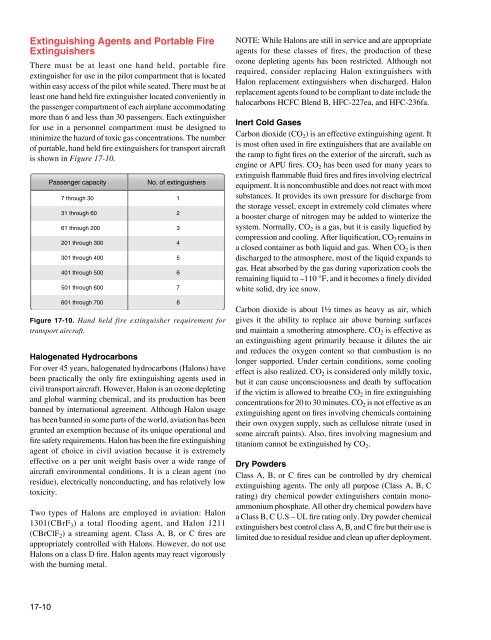ama_Ch17
ama_Ch17
ama_Ch17
Create successful ePaper yourself
Turn your PDF publications into a flip-book with our unique Google optimized e-Paper software.
Extinguishing Agents and Portable Fire<br />
Extinguishers<br />
There must be at least one hand held, portable fire<br />
extinguisher for use in the pilot compartment that is located<br />
within easy access of the pilot while seated. There must be at<br />
least one hand held fire extinguisher located conveniently in<br />
the passenger compartment of each airplane accommodating<br />
more than 6 and less than 30 passengers. Each extinguisher<br />
for use in a personnel compartment must be designed to<br />
minimize the hazard of toxic gas concentrations. The number<br />
of portable, hand held fire extinguishers for transport aircraft<br />
is shown in Figure 17-10.<br />
Passenger capacity<br />
7 through 30<br />
31 through 60<br />
61 through 200<br />
201 through 300<br />
301 through 400<br />
401 through 500<br />
501 through 600<br />
601 through 700<br />
No. of extinguishers<br />
Figure 17-10. Hand held fire extinguisher requirement for<br />
transport aircraft.<br />
Halogenated Hydrocarbons<br />
For over 45 years, halogenated hydrocarbons (Halons) have<br />
been practically the only fire extinguishing agents used in<br />
civil transport aircraft. However, Halon is an ozone depleting<br />
and global warming chemical, and its production has been<br />
banned by international agreement. Although Halon usage<br />
has been banned in some parts of the world, aviation has been<br />
granted an exemption because of its unique operational and<br />
fire safety requirements. Halon has been the fire extinguishing<br />
agent of choice in civil aviation because it is extremely<br />
effective on a per unit weight basis over a wide range of<br />
aircraft environmental conditions. It is a clean agent (no<br />
residue), electrically nonconducting, and has relatively low<br />
toxicity.<br />
Two types of Halons are employed in aviation: Halon<br />
1301(CBrF 3 ) a total flooding agent, and Halon 1211<br />
(CBrClF 2 ) a streaming agent. Class A, B, or C fires are<br />
appropriately controlled with Halons. However, do not use<br />
Halons on a class D fire. Halon agents may react vigorously<br />
with the burning metal.<br />
1<br />
2<br />
3<br />
4<br />
5<br />
6<br />
7<br />
8<br />
NOTE: While Halons are still in service and are appropriate<br />
agents for these classes of fires, the production of these<br />
ozone depleting agents has been restricted. Although not<br />
required, consider replacing Halon extinguishers with<br />
Halon replacement extinguishers when discharged. Halon<br />
replacement agents found to be compliant to date include the<br />
halocarbons HCFC Blend B, HFC-227ea, and HFC-236fa.<br />
Inert Cold Gases<br />
Carbon dioxide (CO 2 ) is an effective extinguishing agent. It<br />
is most often used in fire extinguishers that are available on<br />
the ramp to fight fires on the exterior of the aircraft, such as<br />
engine or APU fires. CO 2 has been used for many years to<br />
extinguish flammable fluid fires and fires involving electrical<br />
equipment. It is noncombustible and does not react with most<br />
substances. It provides its own pressure for discharge from<br />
the storage vessel, except in extremely cold climates where<br />
a booster charge of nitrogen may be added to winterize the<br />
system. Normally, CO 2 is a gas, but it is easily liquefied by<br />
compression and cooling. After liquification, CO 2 remains in<br />
a closed container as both liquid and gas. When CO 2 is then<br />
discharged to the atmosphere, most of the liquid expands to<br />
gas. Heat absorbed by the gas during vaporization cools the<br />
remaining liquid to –110 °F, and it becomes a finely divided<br />
white solid, dry ice snow.<br />
Carbon dioxide is about 1½ times as heavy as air, which<br />
gives it the ability to replace air above burning surfaces<br />
and maintain a smothering atmosphere. CO 2 is effective as<br />
an extinguishing agent primarily because it dilutes the air<br />
and reduces the oxygen content so that combustion is no<br />
longer supported. Under certain conditions, some cooling<br />
effect is also realized. CO 2 is considered only mildly toxic,<br />
but it can cause unconsciousness and death by suffocation<br />
if the victim is allowed to breathe CO 2 in fire extinguishing<br />
concentrations for 20 to 30 minutes. CO 2 is not effective as an<br />
extinguishing agent on fires involving chemicals containing<br />
their own oxygen supply, such as cellulose nitrate (used in<br />
some aircraft paints). Also, fires involving magnesium and<br />
titanium cannot be extinguished by CO 2 .<br />
Dry Powders<br />
Class A, B, or C fires can be controlled by dry chemical<br />
extinguishing agents. The only all purpose (Class A, B, C<br />
rating) dry chemical powder extinguishers contain monoammonium<br />
phosphate. All other dry chemical powders have<br />
a Class B, C U.S – UL fire rating only. Dry powder chemical<br />
extinguishers best control class A, B, and C fire but their use is<br />
limited due to residual residue and clean up after deployment.<br />
17-10


